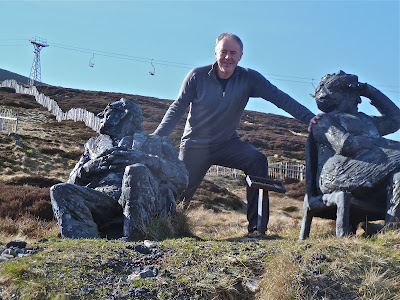We walked briefly southwards along the West Highland Way and then skirted across the hillside to the Allt a' Chuilinn. The ground was saturated, and for once, I was pleased that I had decided to wear boots and gaiters. It was difficult to cross the river after recent rains; there was a veneer of slippery vegetation on the rocks. We continued upstream, crossed the river in the corrie and then headed for a bealach to the east of Meall nan Tarmachan on the Beinn Chabhair ridge. From about 650m, we were walking through soft snow, and the ridge was in winter condition with a layer of hard ice below the recent sprinkling of snow. The summit was chilly in the north-westerly breeze with a lone walker circling the cairn as he munched on a doorstep of a sandwich.
We started the descent down the snow slopes, sledging some of the way down on our jackets to the 619m bealach between Beinn Chabhair and the next two munros. We stopped for lunch and we were joined by a Raven who seemed to enjoy some of my Wensleydale and Geeta's Mango Chutney sandwich to such an extent that he then sat behind me waiting for me to retrieve my second sandwich. John threw him a few nuts and raisins to distract him, and he squawked or choked loudly before taking flight.
The climb up to Bealach Buidhe was long and hard, but once on the ridge, there was an enjoyable canter on the path which threaded up to the collection of tops that is Beinn a'Chroin. The weather had settled, and we had a good walk out and back in the reflected and brilliant light of the snow and ice. We returned to the bealach and started the ascent of An Caisteal, during which the views opened up across to Cruach Ardrain and Ben More and the north, with even Ben Nevis visible. To the south, Loch Long was glinting in the late afternoon sun, and we lingered on the summit, enjoying the spectacular views in all directions.
The descent was down the snow slopes towards Stob Glas and then into Coire a' Chuilinn for the walkout. It had been a tiring day with the boggy ground on the lower slopes and the soft snow higher up, but walking on winter's days such as this is beguiling. The last time we had done these munros together, we had also climbed Cruach Ardrain and Beinn Tulaichean in mid-December. We had made a dangerous descent through the rocky outcrops on Beinn Tulaichean in the mist and dark, from which John still has scars. This time, it was just fond memories, and we had enough light to drive home. A friend, on reading the post, sent me this linearised version of my friend the Raven. It is less scary than the real thing.
 |
| My friend the Raven |



























































